Sailfin Blenny
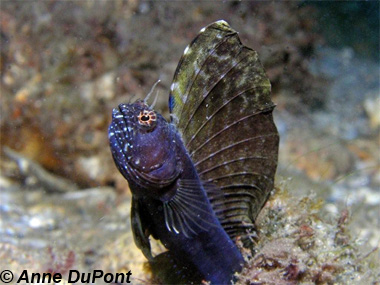
Emblemaria pandionis
This small fish has a long, scaleless body and a large, distinct dorsal fin that tends to be larger on males. Their blunt faces are topped with a cirrus above each eye and next to the nostrils. They live in clear, shallow water along rocky shores or reefs where there is rubble or crevasses for them to hide in. They are shy but territorial fish that live in loose colonies.
Order: Perciformes
Family: Chaenopsidae
Genus: Emblemaria
Species: pandionis
Common Names
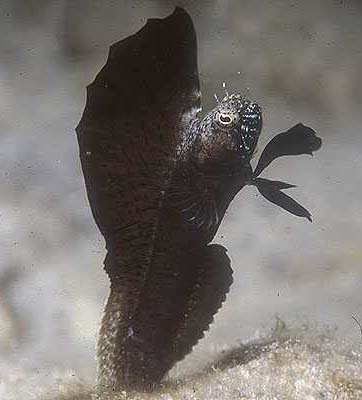
Common names of this species in the English language only consist of sailfin blenny. Other common names include blénido bandera negra (Spanish), sapito dragon (Spanish), and tubícola dragón (Spanish).
Importance to Humans
The sailfin blenny is occasionally seen in the aquarium trade due to its small size and interesting behaviors.
Conservation
At this time, the World Conservation Union (IUCN) does not consider the sailfin blenny to be vulnerable or threatened.
> Check the status of the sailfin blenny at the IUCN website.
The IUCN is a global union of states, governmental agencies, and non-governmental organizations in a partnership that assesses the conservation status of species.
Geographical Distribution

The sailfin blenny is found in the western Atlantic Ocean from the Bahamas, Puerto Rico, and the northern Gulf of Mexico to northern South America.
Habitat
This member of the Chaenopsidae resides in clear shallow waters from rocky shores to coral reefs at depths ranging from 3-39 feet (1-12 m). It is often observed living in abandoned worm holes, coral rubble and channel edges where crevices and holes are available. This blenny rests in holes, propped up by its elongated ventral fins. It is a shy species, leaving the protection of its hole only for short periods of time. Individuals aggregate in colonies, over a large expanse that allows for suitable habitat.
Biology
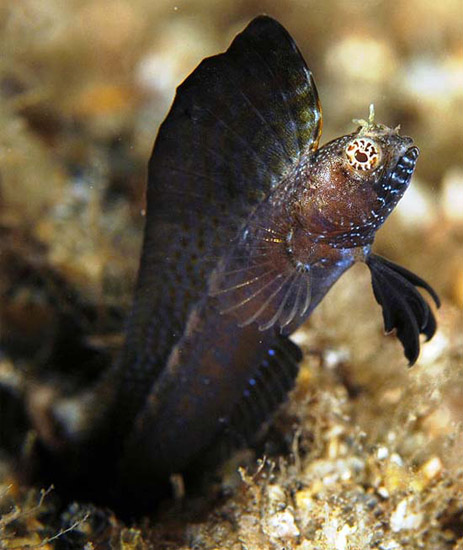
Distinctive Features
It has an elongated scaleless body with a blunt head and snout. The lateral line is absent. Above each eye is a fleshy appendage referred to as a cirrus. There is also a cirrus located at the edge of the nostril on each side. The lower jaw projects out further than the upper jaw. The single dorsal fin is quite large on males and is a distinguishing characteristic while the dorsal fin is much lower in females. Males also have paddle-shaped pelvic fins.
Coloration
Coloration is sexually dimorphic. Females are light tan in color with a scattering of small pale spots and darker flecks. The head is mottled and the body is marked with scattered irregular bars and stripes. The dorsal fin has diagonal broken dark and light lines on the anterior portion. The caudal fin is clear. Males are typically darker in color, with a black head and body. There are approximately 14 blue irregular spots on each side along the base of the dorsal fin. The lips and lower portion of the head have scattered pearly spots. The pectoral fin is clear while the pelvic fin is dark in color. The dorsal fin generally has the same coloration as the body with irregular bands sloping diagonally downward on the posterior portion. There are also darker bands on the anterior lobe of the dorsal fin. The anal fin is dark with white tips on the soft rays. There are no white tips on the anal spines. Males also have a paler mottled coloration when disturbed. Immature sailfin blennies are straw-colored with scattered small spots and dark flecks.
Dentition
The sailfin blenny has 9 stout and bluntly pointed palatine teeth. The teeth on the dentary are large and compressed with approximately 24 on each ramus. The 5th thru 10th teeth are enlarged and slightly recurved. There is a secondary patch of smaller conical teeth on each side of the symphysis.
Size, Age, and Growth
The maximum reported size of the sailfin blenny is 2 inches (5 cm) total length.
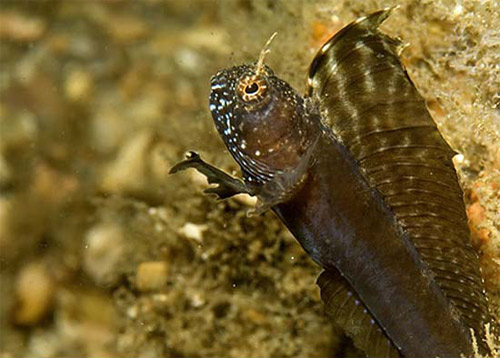
Food Habits
The sailfin blenny is a carnivore, feeding on small invertebrates and plankton. These items include copepods, amphipods, isopods, decapods, stomatopods, mysids, and crabs.
Reproduction
During daylight hours, the male sailfin blenny performs a distinct display by moving its large dorsal fin up and down several times prior to retreating to its hole. Up to 1,100 “flagging” episodes per day have been documented in this species. It is believe that this activity is related to courtship as well as to defending territories from other sailfin blennies. Little else is known about reproduction in this species.
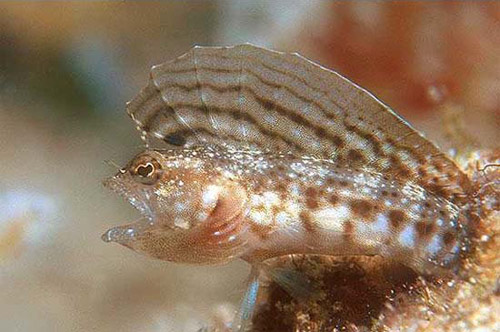
Predators
The sailfin blenny has many potential predators based on its small size. A predation event was observed during behavioral research of a reef squid (Sepioteuthis sepioidea), feeding on a male sailfin blenny as it exited its shelter to signal.
Taxonomy
The sailfin blenny was originally described as Emblemaria pandionis by Evermann and Marsh in 1900. There are no known synonyms appearing in past scientific literature referring to this species. The family Chaenopsidae includes 14 genera represented 90 species of pike-blennies, tube-blennies and flagblennies. They are all scaleless and lack lateral lines. The name Chaenopsidae is derived from the Greek “chaino” meaning with mouth open and “ops” meaning similar to.
Prepared by: Cathy Bester